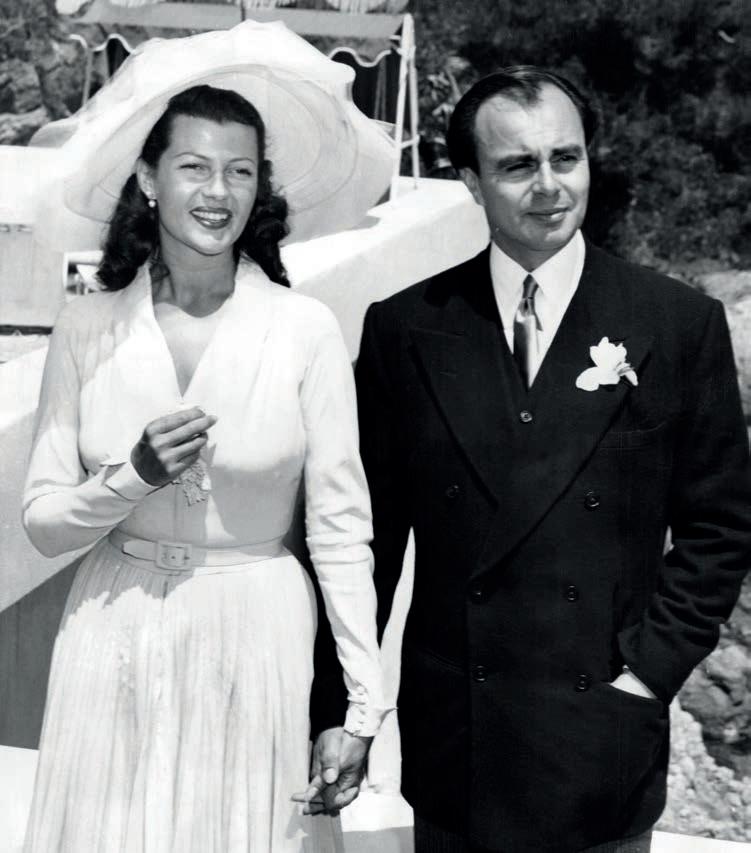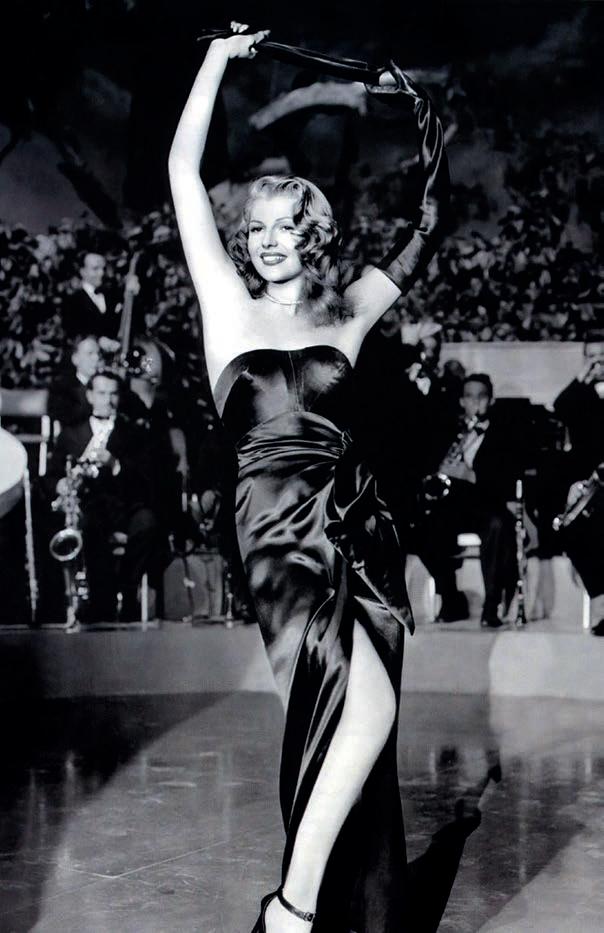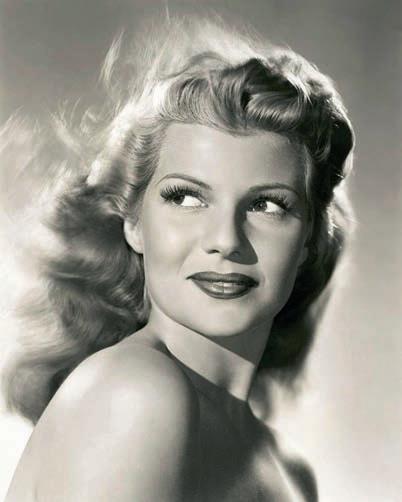
13 minute read
Icon: Rita Hayworth
Rita Hayworth
THE GLAMOUR GODDESS OF HOLLYWOOD
By Eva del Amo
If we were to name Margarita Carmen Cansino, it is highly unlikely that anyone would know who we were referring to. However, this is the real name of the actress Rita Hayworth, a true Hollywood legend of the 40s.
Daughter of the Spanish dancer, Eduardo Cansino Reina, born in Seville, and Volga Margaret Hayworth, an Anglo-Irish dancer, Rita was born in New York on October 17, 1918. Her childhood was not as happy as a girl might wish. With two younger brothers, Rita’s father reluctantly agreed for her to go to school. “From the moment I was able to stand on my feet, at the age of three, I started dance lessons. I didn’t enjoy it, but I didn’t have the courage to tell my father. Rehearse, rehearse and rehearse. That was my childhood.” she confessed in an interview years later.
When she was twelve, Rita’s father decided that the time had come for her to turn professional. He forced her to stop attending school and made her his dance partner. But fate had other plans for her. After performing at a club in Tijuana (Mexico), a Fox Film producer noticed her and offered her a film career. From that moment on, she was renamed Rita Cansino, and at just 16, she debuted on the big screen with a brief role in Dante’s Inferno.
A STAR IS BORN At the age of 18, Rita married Edward Judson in Las Vegas, despite her parents’ opposition. Her husband, 20 years older, had contacts in the film industry and was determined to make her a mo- vie star. He had Rita lose a few kilos, dye her hair red, and undergo electrolysis to raise her low hair- line and thus make her more attractive. Lastly, he changed her name. From that moment on she would be known as Rita Hayworth. Judson got Rita a contract with Columbia Pic- tures, producer of some of Hollywood’s most fa- mous stars. Her first leading role was as a secon- dary actress in Only Angels Have Wings, directed by Howard Hawks, sharing the screen with Cary Grant, already an actor of great renown. The ac- tress began to be noticed by audiences and critics alike, and she started to get more prominent roles. Her shy nature contrasted with the enormous for- titude she displayed on the big screen.

TWO STORMY MARRIAGES Things were starting to go well for her professio- nally, although not personally. The actress was not left with very fond memories of her first husband. “He helped me with my career and helped himself to my money,” the actress said later in an inter- view. When they separated, Judson kept all the marital assets, leaving the actress on the verge of bankruptcy. The next man she fell in love with was a young Or- son Welles. They say that it was love at first sight for the actor and director of Citizen Kane when he saw her on the cover of Life magazine. That day he swore he would marry her, and he soon fulfi- lled his promise. Nicknamed “The Beauty and the Brains” in the world of Hollywood, the couple had a daughter, Rebecca, bringing true happiness to Rita, who had always wanted to be a mother.

THE PATH TO SUCCESS Hayworth, now with 20th Century Fox, who had rejected her years earlier, began a successful career. Along with Tyrone Power, she starred in Blood and Sand, becoming the highest-paid actress of the time. At the peak of her fame, she appeared in You’ll Never Get Rich, a musical comedy with Fred Astaire that was a resounding success with audiences. Three years later, in 1946, she starred in Gilda, a film noir directed by Charles Vidor that led her to achieve absolute stardom, and with which she came to be considered one of the most spellbinding female characters in cinema history. The mythical scene in which the actress plays Put the Blame on Mame, while suggestively peeling off her long black glove, is considered one of the most iconic of the big screen. The scene itself caused a great scandal in many parts of the world. In Spain it was considered “seriously dangerous”, and in many other countries the film was not even released for the same reason. However, the audiences were already extolling the actress, who was starting to be known as “The Love Goddess.” Such was her fame that an expedition to the Andes Mountains took a copy of the film with them, just to bury it, so that it could be preserved in case of a nuclear disaster. At the same time, American soldiers put a picture of the actress under the name of “Gilda” on the tip of the atomic bomb that was dropped in a testing program by the U.S. on Bikini Island.

This caused a deep malaise in the actress, who had always shown herself to be a pacifist.
GRADUAL RETIREMENT The peak of her fame coincided, however, with a marital crisis which led Hayworth to make a statement in front of the cameras that would make her even more famous: “Men go to bed with Gilda, but wake up with me.” Before their breakup, the actress and the director made one more film together, The Lady from Shanghai, which was not particularly successful, because Welles had the actress cut her hair and dye it platinum blonde, and gave her a character with a tragic end, which her fans did not appreciate. It was only with time that the film took its place in history. Rita Hayworth herself would confess years later: “I knew we were making a classic while we were filming it.” Gilda marked a turning point in the career of the actress, who would never again star in such a successful film. In 1947, Hayworth separated from Orson Welles to find love again with Prince Aly Khan, who became her third husband. The magazines did a full-colour feature of their wedding, in a beautiful setting on the French Riviera. Rita and Aly were married on a bed of 30,000 roses, next to a pool scented with cologne. After having a daughter, Princess Yasmin, the marriage ended in 1953, leaving the actress once again in financial and emotional distress. After the prince came two more marriages which also ended in failure. Rita Hayworth was gradually withdrawing from the film industry. In the 70s, she only worked in modest films, due to her physical deterioration and the inability to memorise the scripts correctly. The first symptoms of Alzheimer’s were surfacing, although she did not obtain a precise diagnosis until 1980. In her last years, she was taken care of by her daughter Yasmin, and on May 14, 1987, she died with the same humility that had characterised her beginnings as an actress. She was 68 years old, and had not remembered who she was for some time. However, the profession wanted to pay their last respects to her. Funeral events took place in the church of the Good Shepherd, in Beverly Hills. Among the coffin-bearers were Ricardo Montalbán, Glenn Ford and Don Ameche, who spoke of her with the utmost of affection before the press. Rita Hayworth is buried at Holy Cross Cemetery, Culver City (California). Practically every day, fresh flowers are left on her grave by those who do not forget her beauty and talent during a time when films were essentially made to revere women like her.
Rita Hayworth
La diosa del glamour de Hollywood

Hija del bailarín español Eduardo Cansino Reina, natural de Sevilla, y de Volga Margaret Hayworth, bailarina de origen anglo-irlandés, Rita nació en Nueva York el 17 de octubre de 1918. Su infancia no fue todo lo feliz que una niña podría desear. Con dos hermanos más, el padre de Rita aceptaba a regañadientes que fuese al colegio. “Desde que pude mantenerme en pie, con tres años, recibí clases de baile. N o me gustaba, pero no tenía el valor de decírselo a mi padre. Ensayar, ensayar y ensayar. Así fue mi infancia”, confesaba años más tarde en una entrevista. A l os doce años, el padre de Rita decidió que había llegado el momento de hacerla profesional. Hizo que se dejara de asistir a la escuela y la convirtió en su pareja de baile. Pero el destino tenía otros planes para ella. Tras su actuación en un club de Tijuana (México), un productor de la Fox se fijó en ella y le propuso una carrera cinematográfica. Desde entonces pasó a denominarse Rita Cansino y con solo 16 años debutó en la gran pantalla con un breve papel en El infierno de Dante.
NA CE UNA ESTRELLA A los 18 años, Rita se casó en Las Vegas con Edward Judson, a pesar de la oposición de sus padres. S u marido, 20 años mayor, tenía contactos en la industria cinematográfica y estaba decidido a convertirla en una gran estrella de cine. Hizo que Rita adelgazara unos cuantos kilos, la tiñó de pelirroja y la obligó a someterse a una depilación por electrólisis y retrasar así la línea de crecimiento de su pelo para tener una imagen más atractiva. Por último, la cambió el nombre. A partir de ese momento sería conocida como Rita Hayworth. Judson consiguió a Rita un contrato con Columbia Pictures, productora de algunas de las estrellas más famosas de Hollywood. Su primer papel destacado fue como actriz secundaria en Solo los ángeles tienen alas, de Howard Hawks, compartiendo pantalla con Cary Grant, un actor ya consagrado. El público y la crítica comenzaron a fijarse en ella, y a la actriz empezó a conseguir papeles más destacados. Su carácter tímido contrastaba con la enorme fuerza que tenía en la gran pantalla.
DOS MATRIMONIOS TORMENTOSOS Las cosas comenzaban a marchar bien en el terreno profesional, pero no en el personal. De su primer marido la actriz no guardaría un buen recuerdo. “Él me ayudó con mi carrera y se ayudó a sí mismo con mi dinero”, afirmaba la actriz posteriormente en una entrevista. Cuando se separó, Judson se quedó con todos los bienes del matrimonio, dejando a la actriz casi en la ruina. El siguiente hombre del que se enamoró fue un joven Orson Welles. Cuentan que el actor y director de Ci udadano Kane se enamoró de ella nada más verla en la portada de la revista Life. Ese día juró que iba a casarse con ella y poco después cumplió su promesa. Apodados en el mundo de Hollywood como “la Bella y el Cerebro”, juntos tuvieron a una hija, Rebecca, que colmó de felicidad a Rita, que siempre había deseado ser madre.
EL CAMINO DEL ÉXITO Hayworth, ya en la 20th Century Fox, que años antes la había rechazado, comienza una carrera de éxito. Junto a Tyrone Power interpreta Sangre y Arena, convirtiéndose en la actriz mejor pagada del momento. En la cima de la fama intervino en Desde aquel beso, una comedia musical junto a Fred Astaire que tuvo una inmejorable acogida por el público. Tres años después, en 1946, protagonizaría Gilda, la película de cine negro de Charles Vidor que t erminó de lanzarla al estrellato, con el que es considerado uno de los personajes femeninos más deslumbrantes de la historia del cine. La mítica escena en la que la actriz interpreta Put the blame on M ame mientras se quita sugerentemente un guante es considerada una de las icónicas del cine. L a escena en sí causó un gran escándalo en gran parte del mundo. En España fue considerada “gravemente peligrosa” y en muchos otros países ni se l legó a estrenar por este motivo. Sin embargo, el público ya había encumbrado a la artista, que ya comenzaba a ser conocida como “la diosa del amor”. Su fama fue tal que una expedición llevó una copia de la película a la Cordillera de los Andes, solo p ara enterrarla y que pudiera conservarse en caso de desastre nuclear. En esa misma época, soldados estadounidenses pusieron una imagen de la actriz bajo el nombre de “la diosa del amor” en la punta de la bomba atómica que fue arrojada por EE.UU. en sobre las islas Bikini, en periodo de pruebas, lo que causó un profundo malestar en la actriz, que siempre se había manifestado como pacifista.
RETIRADA PAULATINA Los momentos de mayor fama coinciden, sin embargo, con una crisis en su matrimonio, lo que le llevó a Hayworth a exclamar delante de las cámaras u na frase que le haría más célebre aún: “los hombres se van a la cama con Gilda, pero se levantan conmigo”. Antes de que se separaran, la actriz y el director ruedan una película más, La dama de Shanghái, que no tuvo demasiado éxito porque Welles cortó el pelo a la actriz, la tiñó de rubio platino y le dio un personaje con un final trágico, lo que no gustó a sus seguidores. El tiempo fue el único que concedió a la película su lugar en la historia. La misma Rita Hayworth confesaría años más tarde que “sabía que estábamos haciendo un clásico mientras la rodábamos”. Gilda fue un punto de inflexión en la carrera de la actriz, que nunca volvió a protagonizar una película con tanto éxito. En 1947 Hayworth se separa de O rson Welles para volver a encontrar el amor con el príncipe Ali Khan, quien se convirtió en su tercer esposo. Las revistas dieron a todo color su boda, en un precioso paraje de la Rivera francesa. Rita y Ali se casaron sobre un lecho de 30.000 rosas y junto a una piscina llena de agua de colonia. Tras tener una hija, la princesa Yasmin, el matrimonio se disolvió en 1953, dejando de nuevo a la actriz arruinada y hundida. Detrás del príncipe llegaron dos matrimonios que también terminaron en fracaso. Poco a poco, Rita Hayworth se fue retirando de la industria del cine. Durante los años 70 ya solo trabajó en películas modestas ante su deterioro físico y la imposibilidad de memorizar bien los guiones. El Alzheimer h abía hecho acto de presencia, aunque no obtuvo un diagnóstico exacto hasta 1980. En los últimos años fue cuidada por su hija Yasmin y el 14 de mayo de 1987 murió con la sencillez que había caracterizado sus comienzos como actriz. Tenía 68 años y hacía tiempo que ya no recordaba quién era. Sin embargo, la profesión quiso acompañarla en su último adiós. Los actos fúnebres tuvieron lugar en la iglesia del Buen Pastor, en Beverly Hills. Entre los portadores de su féretro estaban Ricardo Montalbán, Glenn Ford y Don Ameche, quienes la recordaron frente a la prensa con infinito cariño. Rita Hayworth está enterrada en el cementerio de Holy Corss, en Culver City (California). Prácticamente a diario recibe flores frescas, de quienes no olvidan su belleza y su talento, en una época en la que el cine estaba hecho, básicamente, para admirar a mujeres como ella.

IF YOU’D LIKE TO APPEAR IN OUR FACES & PLACES SECTION contact us, and we’ll inform you about how we can promote your event.
Si estás interesado en aparecer en nuestra sección FACES & PLACES, contacta con nosotros y te informaremos de cómo podemos promocionar tu evento.
Rafael Barrio. Tel: +34 607 223 784 · info@exclusivelifemagazine.com · www. exclusivelifemagazine.com















